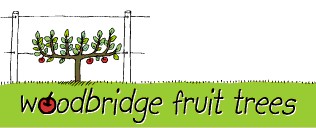No products
 View larger
View larger
Receiving Your trees
Nik Magnus | updated 2023 Woodbridge Fruit Trees | www.woodbridgefruittrees.com.au
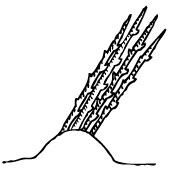
Heeled in
BEFORE PLANTING
When you receive your plants, they will still be dormant, and will survive easily in their packaging for 1-2 weeks before planting. Open the bag and pour in a cup of water every week to ensure the roots stay moist. Before planting, it’s a good idea to stand them in a bucket of water overnight, mix in some soluble seaweed solution if you have it. Alternatively If you’re not ready to plant them you can “heel them in” a temporary position for a few weeks. Just bury the roots in a pile of moist sawdust or loose soil, and keep moist. At no stage allow the roots to dry out. Also, don’t let the roots sit in water for more than a few days, or they may start to rot.
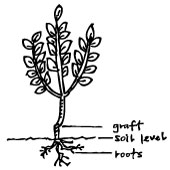
The young fruit tree
PLANTING
Dig a hole 40-50cm diameter and similar depth. Hopefully you have already prepared the hole earlier and composted some manure or added some better soil if the ground is poor. I suggest soaking the roots for a few hours or overnight in some dilute seaweed solution to encourage new root growth. Plant your bare rooted tree, burying the roots and keep the graft union well above the soil level. Settle young trees in by firming the soil and watering them in well. DO NOT add fertiliser at this stage.
PRUNING
The most important job for the new fruit tree is that the roots get established first, followed by the growth of leaves, branches and flowers. Pruning the tree reduces the amount of leaf emerging in spring when the roots are not fully working. I'd recommend pruning a fruit tree after planting in MOST situations, and you will end up with a better result.
ESPALIERED or FREE STANDING?
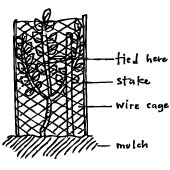
Snugly planted, staked caged and mulched
The way you plant and then prune your tree depends if you wish to espalier it or have it free standing. For free standing trees, prune it somewhere around 60cm-80cm from the ground after planting. Doing this will encourage it to branch where it has been cut, producing a tree with a more open shape. A firm stake or two tied to the tree to add support is recommended.
Espalier systems are all different, but the KNNN method (see separate article 'KNNN') requires that you plant the stem at about 60 degrees and to not prune the tree, instead bending it horizontal to tie onto the bottom wire of the espalier. For the traditional T-shaped espalier (see separate article 'Espalier made Easy'), plant the tree vertically and prune it at the level of the first wire.
PROTECTION
Young trees need protection from nibbling possums, wallabies, goats, rabbits, horses and husbands with whipper-snippers. A cage or guard is recommended.
MULCHING, FEEDING and WATERING.
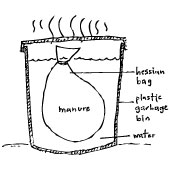
After planting, mulch well and maintain a weed free area around each plant. Avoid fertilizer when planting, doing so can damage the roots that are not yet able to process high amounts of nutrients. Instead, apply it when the plant begins growing in mid spring. It will need a few applications of fertiliser and / or manure during the spring, summer and autumn growth periods. Fresh manure can burn the plant and it is recommended to digest it first either in a compost heap or in a drum with water added. A watering system using drippers is an easy and effective way of watering your trees. An automatic tap-timer can help too.
DONT OVER FEEDING TOO EARLY
Feeding too early will result in damage to the roots that are not yet able to process the high nutients. As a general rule, only apply fertilizer during the growing season. Avoid fertilizer when planting.
This product is no longer in stock
Nik Magnus | updated 2023 Woodbridge Fruit Trees | www.woodbridgefruittrees.com.au

Heeled in
BEFORE PLANTING
When you receive your plants, they will still be dormant, and will survive easily in their packaging for 1-2 weeks before planting. Open the bag and pour in a cup of water every week to ensure the roots stay moist. Before planting, it’s a good idea to stand them in a bucket of water overnight, mix in some soluble seaweed solution if you have it. Alternatively If you’re not ready to plant them you can “heel them in” a temporary position for a few weeks. Just bury the roots in a pile of moist sawdust or loose soil, and keep moist. At no stage allow the roots to dry out. Also, don’t let the roots sit in water for more than a few days, or they may start to rot.

The young fruit tree
PLANTING
Dig a hole 40-50cm diameter and similar depth. Hopefully you have already prepared the hole earlier and composted some manure or added some better soil if the ground is poor. I suggest soaking the roots for a few hours or overnight in some dilute seaweed solution to encourage new root growth. Plant your bare rooted tree, burying the roots and keep the graft union well above the soil level. Settle young trees in by firming the soil and watering them in well. DO NOT add fertiliser at this stage.
PRUNING
The most important job for the new fruit tree is that the roots get established first, followed by the growth of leaves, branches and flowers. Pruning the tree reduces the amount of leaf emerging in spring when the roots are not fully working. I'd recommend pruning a fruit tree after planting in MOST situations, and you will end up with a better result.
ESPALIERED or FREE STANDING?

Snugly planted, staked caged and mulched
The way you plant and then prune your tree depends if you wish to espalier it or have it free standing. For free standing trees, prune it somewhere around 60cm-80cm from the ground after planting. Doing this will encourage it to branch where it has been cut, producing a tree with a more open shape. A firm stake or two tied to the tree to add support is recommended.
Espalier systems are all different, but the KNNN method (see separate article 'KNNN') requires that you plant the stem at about 60 degrees and to not prune the tree, instead bending it horizontal to tie onto the bottom wire of the espalier. For the traditional T-shaped espalier (see separate article 'Espalier made Easy'), plant the tree vertically and prune it at the level of the first wire.
PROTECTION
Young trees need protection from nibbling possums, wallabies, goats, rabbits, horses and husbands with whipper-snippers. A cage or guard is recommended.
MULCHING, FEEDING and WATERING.

After planting, mulch well and maintain a weed free area around each plant. Avoid fertilizer when planting, doing so can damage the roots that are not yet able to process high amounts of nutrients. Instead, apply it when the plant begins growing in mid spring. It will need a few applications of fertiliser and / or manure during the spring, summer and autumn growth periods. Fresh manure can burn the plant and it is recommended to digest it first either in a compost heap or in a drum with water added. A watering system using drippers is an easy and effective way of watering your trees. An automatic tap-timer can help too.
DONT OVER FEEDING TOO EARLY
Feeding too early will result in damage to the roots that are not yet able to process the high nutients. As a general rule, only apply fertilizer during the growing season. Avoid fertilizer when planting.
Reviews
No customer reviews for the moment.
